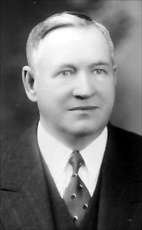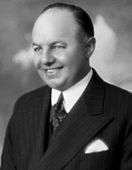Duncan Marshall
| Duncan McLean Marshall | |
|---|---|
 The Hon. Duncan McLean Marshall | |
| Canadian Senator Ontario | |
|
In office January 20, 1938 – January 16, 1946 | |
| Personal details | |
| Born |
September 24, 1872 Elderslie Township, Ontario |
| Died | January 16, 1946 (aged 73) |
| Political party | Liberal |
Duncan McLean Marshall (born: September 24, 1872 Elderslie Township, Ontario - died: January 16, 1946) was a Canadian journalist, publisher, rancher provincial level politician and Minister of Agriculture in 2 provinces and later served in the Canadian Senate representing the province of Ontario.
Early life
Marshall's first employment was as a teacher at Gillies Hill, Ontario, Canada.
By 1891 he was involved in the Patrons of Industry movement and was identified as an organizer with the fraternal agricultural organization. In 1895 he was sent to Prince Edward Island and began organizing there and in Nova Scotia and New Brunswick. Early success led to the creation of weekly newspaper under the banner The Patron of Industry in January 1896 but it was closed in November of the same year. During the period Marshall attempted to turn to organization into a political party in the province but did not succeed and he returned to Ontario. The Patrons of Industry was disbanded in 1898.
Marshall moved on to become the Grand Secretary and editor and publisher of the official organ of the Order of Good Templars, a temperance organization.
He later moved to Toronto where he was involved in newspaper publishing and eventually acquired a number of farm interest weeklies. Marshall made his first run at federal politics running in the Muskoka riding in the 1904 Canadian federal election he was defeated by Conservative candidate William Wright.
In 1905 Marshall moved to Alberta and was for three years managing editor of the Edmonton Bulletin. He subsequently purchased a farm near Olds, Alberta and found success as a cattle and horse breeder.[1] He owned The Olds Gazette, a weekly newspaper in Olds, Alberta.
Alberta politics
Marshall was elected to the Legislative Assembly of Alberta for the first time in the 1909 Alberta general election to the new Olds electoral district. He won the new district easily over Conservative candidate George McDonald.
Marshall was appointed to the cabinet by Premier Alexander Cameron Rutherford to serve as the new Minister of Agriculture and Provincial Secretary November 1, 1909. Marshal's Ministerial appointments would last until May 26, 1910 when he and the rest of the Rutherford cabinet resigned in the face of the Alberta and Great Waterways Railway scandal.[2] Marshall would be re-appointed Minister of Agriculture under the new government of Arthur Lewis Sifton on June 1, 1910 but his Provincial Secretary position would be given to Archibald J. McLean.
One of his most notable achievements as Minister of Agriculture was the creation and setup of Demonstration Farms around the province in 1911. These farms would evolve into Agriculture training schools. The most notable of these schools is still in operation today as Lakeland College.[3]
Marshall would seek a second term in office in the 1913 Alberta general election. In that election he would defeat Conservative challenger George Cloakey by just 54 votes.
Cloakley would run against Marshall again in the 1917 Alberta general election but would not succeed in defeating Marshall the second time, instead Marshall substantially widened his plurality winning comfortably.
Marshall would go down to defeat in the 1921 Alberta general election at the hands of Nelson Smith from the United Farmers of Alberta by an almost 500 vote plurality. The defeat of Marshall and the Liberal government would mark the end of his role as Minister of Agriculture. He would be replaced in the portfolio by former Conservative Leader George Hoadley.
After Marshall's defeat in the provincial election, he ran for the Liberal Party of Canada for the second time in the 1921 Canadian federal election in East Calgary. He was defeated by William Irvine and finished the race a distant third.
Ontario legislature
Marshall was elected to the Legislative Assembly of Ontario for the Ontario Liberal Party in the 1934 Ontario general election for the Peel electoral district. In that election, he defeated longtime incumbent Conservative Thomas Kennedy. He was appointed Minister of Agriculture from July 10, 1934 to October 12, 1937, serving one term in the legislature.[4] Upon his appointment to the cabinet, he became one of the few in Canadian history to hold the same ministerial portfolio in two different provinces.
Marshall and Kennedy would face each other again in the 1937 Ontario general election; this time, the results would be reversed, with Kennedy defeating Marshall.
Senate appointment
Marshall was appointed to the Canadian Senate on January 20, 1938 by William Lyon Mackenzie King. He served in the Senate representing the Liberal Party of Canada until his death on January 16, 1946.
References
- ↑ Portrait Gallery of the Saddle and Sirloin Club p.38
- ↑ "Sifton is forming the new cabinet". Calgary Herald. May 26, 1910. Retrieved 2007-08-07.
- ↑ "About Lakeland Our History". Lakeland College. Retrieved 2007-08-05.
- ↑ "Duncan McLean Marshall, MPP". Legislative Assembly of Ontario. Retrieved 2007-08-07.
External links
- Legislative Assembly of Alberta Members Listing
- Federal Political Experience Duncan Marshall
- Ontario Legislative Assembly Parliamentarian History
| Alberta Provincial Government of Arthur Sifton | ||
| Cabinet Post (1) | ||
|---|---|---|
| Predecessor | Office | Successor |
| Duncan Marshall | Minister of Agriculture June 1, 1910–August 12, 1921 Re-appointed by Premier Sifton |
George Hoadley |
| Alberta Provincial Government of Alexander Cameron Rutherford | ||
| Cabinet Posts (2) | ||
| Predecessor | Office | Successor |
| William Finlay | Provincial Secretary November 1, 1909–May 26, 1910 Entire cabinet resigned |
Archibald J. McLean |
| William Finlay | Minister of Agriculture November 1, 1909–May 26, 1910 Entire cabinet resigned |
Duncan Marshall |
| Legislative Assembly of Alberta | ||
| Preceded by New District |
MLA Olds 1909–1921 |
Succeeded by Nelson S. Smith |
| Legislative Assembly of Ontario | ||
| Preceded by Thomas Laird Kennedy |
MPP Peel 1934–1937 |
Succeeded by Thomas Laird Kennedy |
